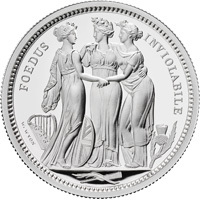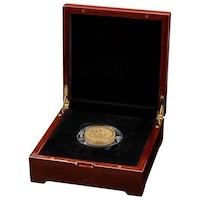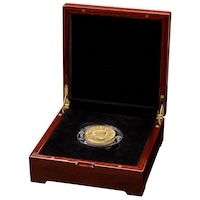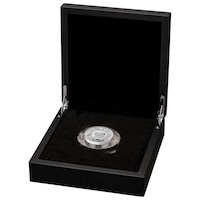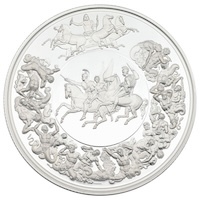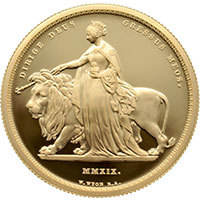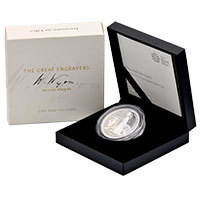
Is this the most impressive medal ever designed in Britain?
Many experts regard Benedetto Pistrucci's Waterloo medal as the engraver's masterpiece. This is high praise considering he also designed the classic St George and the dragon reverse, used on gold Sovereigns.
Commissioned to celebrate the Allied victory at the Battle of Waterloo, Pistrucci's medal took over thirty years to complete and was never struck in his lifetime.
More than 200 years later, the design has been repurposed for UK coinage as a new entry to The Royal Mint's Great Engravers collection. To celebrate this release, we are delving into the complicated story and design of Pistrucci's medal and the milestone battle that inspired it.
The 1815 Battle Of Waterloo
The Battle of Waterloo was fought on 18 June 1815 in modern Belgium.
The battle was the culmination of the War of the Seventh Coalition, the final phase of the Napoleonic Wars that had divided Europe since 1803. In March 1815, Napoleon Bonaparte escaped from the island of Elba and marched on Paris, beginning a period referred to by as the 'Hundred Days'. In response, the four great powers of the era, Russia, Austria, Prussia and the United Kingdom, formed a new alliance intended to end Napoleon's rule for good.
The Hundred Days climaxed with the Waterloo Campaign, fought through June 1815 with the Duke of Wellington in command of a British-led army. With the assistance of Field Marshall Graf von Blücher's Prussian forces, the Coalition would outnumber Napoleon's forces two to one … if they arrived in time.

Clément-Auguste Andrieux's oil painting 'Battle of Waterloo, 18th of June 1815', painted in 1852, long after the campaign.
Later, Wellington would call the Battle of Waterloo 'the nearest-run thing you ever saw in your life'. Regardless of the narrowness of the victory, its significance can hardly be overstated. The Coaliation's triumph precipitated Napoleon's retreat to Paris and his final abdication, effectively ending the Napoleonic Wars. He was later permanently exiled to the island of Saint Helena. The following negotiations would redraw the map of Europe, heralding the Pax Britannica - the decades of relative peace that followed - and the rise of Britain as a dominant military and economic power.
In the immediate aftermath of the Battle, every British soldier who took part in the campaign was awarded a silver medal with their name, rank and regiment stamped on the edge. Previously, the British Government had only issued medals to officers. Some 39,000 Waterloo Medals were produced by the Royal Mint - the UK's national mint - featuring engravings by Thomas Wyon the Younger, cousin of William Wyon.
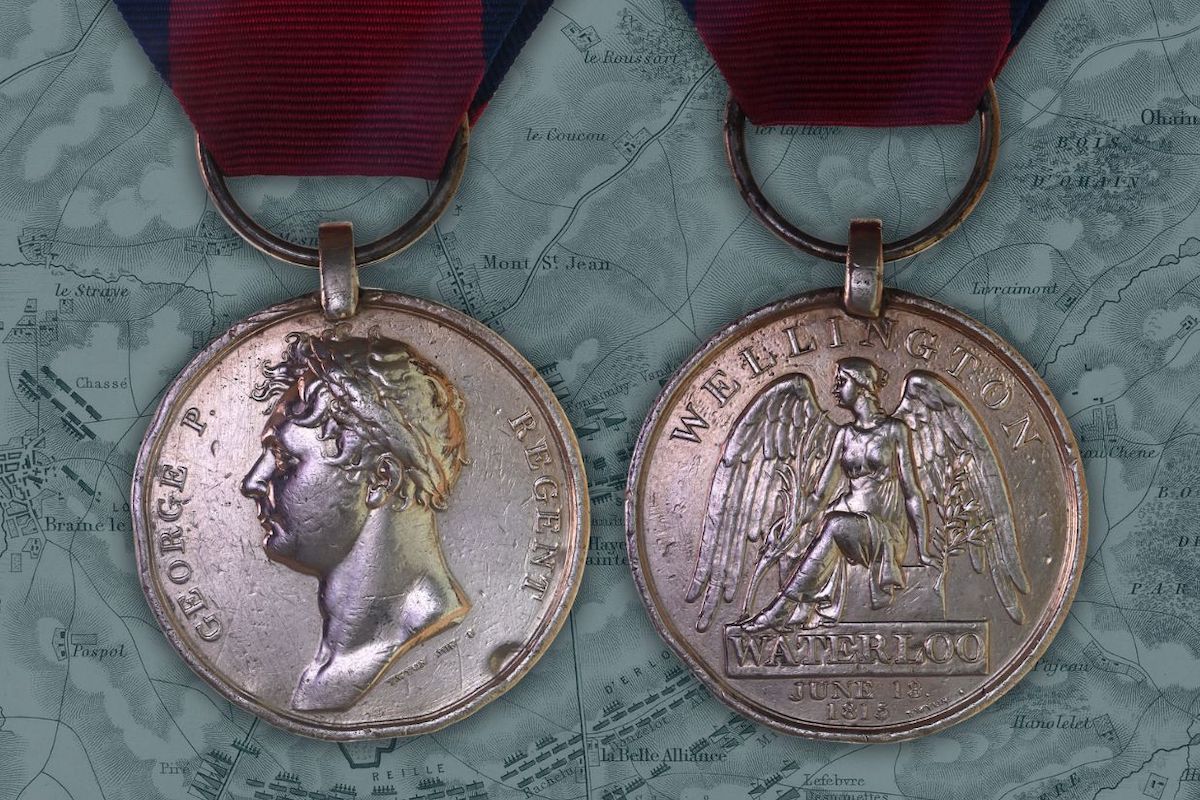
A portrait of the Prince Regent and the winged figure of Victory feature on the Waterloo Medal, the latter inspired by an ancient Greek coin. Credit: RWB Auctions.
In addition to the campaign medal, the Royal Mint was also tasked with creating a medal designed to be presented to the Coalition leaders and generals.
This commemorative medal was proposed as early as 1816 by the Prince Regent (later King George IV). The commission initially fell to the Royal Academy, which nominated a design by the neoclassical sculptor Sir John Flaxman. To create a medal, Flaxman's design would have to be translated onto steel dies. The obvious candidate for this task was an Italian artist recently employed by The Royal Mint.
Who Was Benedetto Pistrucci?
Born in Rome, Benedetto Pistrucci (1783-1855) had arrived in London in the aftermath of Waterloo. He had previously been employed by relatives of Napoleon but quickly turned his talents to charming the British establishment, earning commissions from the great and good.
Pistrucci's first specialism was gem engraving, working at a minute scale on semi-precious stones. This work brought the Italian to the attention of William Wellesley-Pole, brother of the Duke of Wellington and Master of the Royal Mint.

A self-portrait bust of Benedetto Pistrucci, the sculptor behind the Waterloo medal.
Though he had never designed coinage before, Pistrucci's first commission from Wellesley-Pole was to craft a new portrait of King George III as part of an overhaul of British currency, now referred to as the Great Recoinage of 1816. It was Thomas Wyon the Younger who engraved Pistrucci's portrait design onto steel dies to strike coinage. It was, therefore, Wyon that Pistrucci blamed when the so-called 'bull head', used on a limited number of Halfcrowns, Shillings and Sixpences, was mocked in the press.
After that, Pistrucci refused to work from other artists' designs, learning to engrave on steel and personally sinking dies for all his subsequent coinage commissions. This included the instantly recognisable Saint George and the dragon motif for which he is probably best known. This iconic design was created for the first modern gold Sovereigns, issued in 1817. A similar design would later appear on Half Sovereigns, Double Sovereigns, Five Sovereigns, and silver Crowns.
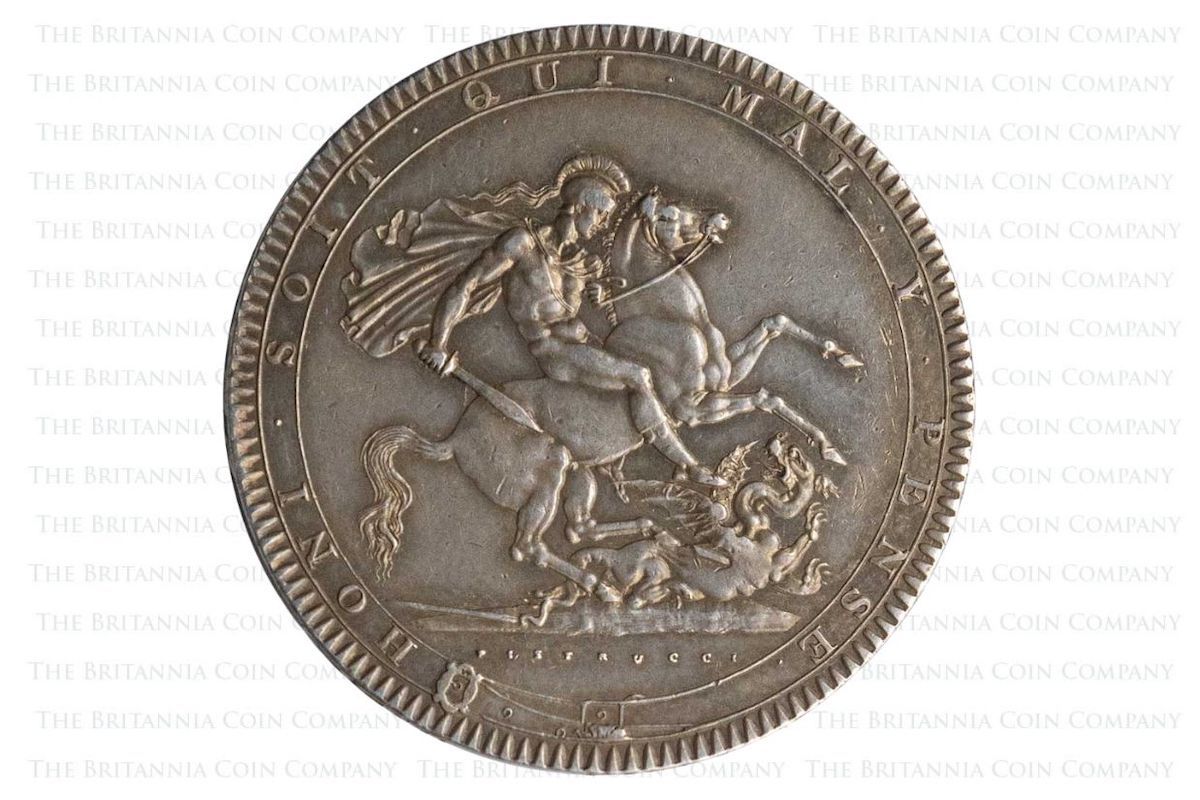
Pistrucci's Saint George and the dragon design, as seen on the reverse of an 1819 silver Crown.
Engraving The Waterloo Medal
Much to the Royal Academy's annoyance, Pistrucci declined to work from John Flaxman's Waterloo medal design and instead produced his own wax models. These were received very well by the Prince Regent, gaining Pistrucci an official commission in August 1819. For the job, Pistrucci was promised the extraordinary sum of £2,400 (approximately £138,000 in 2024). This fee was on top of the artist's £500 annual salary and based on the idea that the Waterloo medal would take the work of 30 ordinary-sized medals to complete.
Vehemently refusing to use a painting by Sir Thomas Lawrence as was initially requested, Pistrucci insisted on in-person sittings with the Prince Regent to model his profile for the Waterloo medal. He made good use of these sessions, also creating models which would be used for official Coronation medals issued when the Prince was crowned as George IV in 1820.
While Pistrucci occupied a position of importance at the mint, he was not officially named Chief Engraver, being ineligible as a foreign national. Despite this, Pistrucci 'relentlessly' pursued the role, using the Waterloo medal as a bargaining chip and thereby delaying its production. Spats about other medal commissions and the replacement of his chief advocate, William Wellesley-Pole, with less admiring Mint Masters resulted in dwindling commissions and increasing scrutiny towards Pistrucci. In 1828, he was appointed Chief Medallist on a reduced salary, following Treasury concerns about his pay. This move prompted resentment directed at his rival, William Wyon, who was appointed Chief Engraver at the same time. In 1836, Pistrucci refused a £500 bonus for taking on apprentices who would help him finish the Waterloo medal. By the 1840s, continued payments to Pistrucci had attracted the attention of the Audit Office, and the medal had become the artist's sole project.
Pistrucci finally presented matrices for the Waterloo medal to the Royal Mint on 1 January 1849.
Design Of Pistrucci's Waterloo Medal
The obverse of the Waterloo Medal shows left-facing portraits of the major allied rulers. The four men are shown in Roman-style dress wearing crowns of laurel leaves as a mark of their triumph. From left to right, the profile busts show:
- George, Prince Regent, later King George IV, who acted as head of state during his father, George III's, illness
- Emperor Francis I of Austria, famously defeated by Napoleon at Austerlitz, married his daughter to the Emperor
- Tsar Alexander I of Russia, switched sides several times during the Napoleonic Wars but joined the Seventh Coalition
- King Frederick William III of Prussia, whose troops turned the tide at Waterloo, attacking the French flank

The obverse of Pistrucci's Waterloo medal with the four allied leaders in the centre.

The Waterloo medal features portraits of the allied leaders: King George IV, Emperor Francis I of Austria, Tsar Alexander I of Russia, and King Frederick William III of Prussia.
Around the four portraits are figures from Greek and Roman mythology.
From the top, moving clockwise, we see Apollo, the personification of the sun, driving a chariot to restore light after decades of conflict. He is followed by Iris, the rainbow that shines after a deluge, and her husband Zephyrus, who holds garlands of flowers symbolising peace and celebration. Beneath them sits the powerful male figure, sometimes identified as Hercules, sheltered by an oak tree, perhaps representing the 'wooden walls of England' (the ships that had defended Britain's shores).
The figure of Night in her chariot, fleeing from Apollo, is seen at the base of the medal's obverse. She is flanked on the left by the Furies holding snakes and trumpets and on the right by the Fates who spin and weave the fabric of human destiny. The Fates sit under Themis, the goddess of justice. She balances peace and virtue, represented by the palm tree to her left, with punishment delivered by the sword in her hand. Above her head fly a pair of youths - the constellation Gemini - referencing the month that Waterloo was fought.
The reverse of the Waterloo medal shows Wellington (left, identifiable by his distinctive nose) and Blücher (right), mounted on rearing horses with the winged figure of Victory in between, guiding their horses into battle.

The reverse of Pistrucci's Waterloo medal shows the Wellington and Blücher with Jupiter above and nineteen defeated giants below.
Above is Jupiter, lightning bolts in hand, driving his quadriga. The king of the Gods has struck down nineteen serpent-footed Giants (as described by Ovid) who tumble defeated around the base of the medal. Their number represents the nineteen long years of war, dating from the beginning of Bonaparte's first Italian campaign in 1796, earlier than the modern dating for the beginning of the Napoleonic wars, which tend to specify the start of the conflict as 1799 or 1803.
Wax models for the Waterloo medal, held by the Della Zecca Museum in Rome, indicate that the medal was intended to be inscribed on both sides with the words 'FOEDERE JUNCTIS' ('Joint League') on the obverse and the date of the battle '15 JUNE 1815' on the reverse.
Striking The Waterloo Medal
By the time Pistrucci delivered the Waterloo medal, 34 years had elapsed since the battle, and much had changed.
Anglo-French relations were sometimes tense, but the two nations would form an alliance during the Crimean War and sign a major trade treaty not long after. There was little will to strike a medal crowing about a notable British victory in this political climate. Additionally, all the leaders on the obverse of the medal, except the Duke of Wellington, were dead, as were many of the intended recipients.
Despite this, Pistrucci provided detailed instructions on how the Royal Mint might successfully strike the medal, promising that 'an accident produced by carelessness or inattention might in one moment entirely destroy the whole work, and without remedy'. Given this risk, the Mint declined to harden the matrices and convert them to dies before Pistrucci's death in 1855.
The weighty matrices and delicate wax models of the Waterloo medal survive in the Royal Mint Museum and the Della Zecca Museum, respectively. Over the years, several electrotype copies and soft models were taken of the matrices, including reduced-size gold, silver, and platinum impressions issued in 1965 by John Pinches Medallists to celebrate the 150th anniversary of the battle.
In 1990, The Royal Mint finally struck a 63-millimetre collector's edition medal to mark the 175th anniversary. The 1990 strike was issued in gold (175 minted), silver (2,500) and bronze (5,000). A similar 80-millimetre silver medal with the lettering restored was offered in 2015 for the 175th anniversary with a limited edition of just 1,815.
Despite never having been struck at its full 130-millimetre size, Pistrucci's Waterloo medal has been highly praised by a range of numismatic writers. It is regarded as his masterpiece of the golden age of coin and medal design.

Detail of the reverse of the Waterloo Medal, as issued by The Royal Mint in 2015.
2024 Great Engravers Waterloo Medal Coins
In 2024 The Royal Mint announced that Pistrucci's Waterloo Medal would be struck on official UK coins as part of The Great Engravers collection.
This premium series features works by some of the UK's greatest coinage designers, including William Wyon and Thomas Simon. Pistrucci's classic Sovereign design was reproduced on a range of 2024-dated St George coins.
Using a combination of original engraving techniques and modern technology, The Royal Mint's design team are able to reproduce the fine detail of rare and beloved historic coins. Pieces from the series, notably 2019's Una and the Lion range, have become highly sought-after collectables in their own right.
The Waterloo Medal will be issued by The Royal Mint as a two-part release. The obverse portraits of the four Allied leaders will be struck first. A second range of coins featuring the reverse design with Wellington and Blucher will follow in 2025. This practice of issuing each side separately, with a royal portrait on the reverse, mirrors the release of the 2021 Gothic Crown.
So far, the following Waterloo Medal coins have been issued:
- 2024 Waterloo Medal Allied Leaders 5kg Gold Proof
- 2024 Waterloo Medal Allied Leaders 2kg Gold Proof
- 2024 Waterloo Medal Allied Leaders 1kg Gold Proof
- 2024 Waterloo Medal Allied Leaders 5oz Gold Proof
- 2024 Waterloo Medal Allied Leaders 2oz Gold Proof
- 2024 Waterloo Medal Allied Leaders 1kg Silver Proof
- 2024 Waterloo Medal Allied Leaders 10oz Silver Proof
- 2024 Waterloo Medal Allied Leaders 5oz Silver Proof
- 2024 Waterloo Medal Allied Leaders 2oz Silver Proof
Mintage figures for this first Waterloo Medal release appear to largely mirror those for the Saint George range, at least for the more accessible 2oz gold proof coin and the silver issues. These figures are significantly lower than those seen for 2021's Gothic Crown and more closely mirror numbers for the earlier releases in The Great Engravers series, including the Three Graces.
Looking to get your hands on a 2024 Waterloo Medal Great Engravers coin? Follow @BritanniaCoinCo on TikTok, YouTube, Instagram and Facebook for updates or subscribe to our mailing list.
Frequently Asked Questions
The first side of Benedetto Pistrucci's Waterloo Medal has been struck on a 2024-dated coin from The Royal Mint, released on 24 June. The 'Allied Leaders' coin is to be followed by the reverse of the monumental medal which will be issued as part of The Great Engravers collection in 2025, coinciding with the 210th anniversary of the Battle of Waterloo.
The issue limits for The Royal Mint's 2024 Waterloo Medal Great Engravers coins are low. They appear to match the figures set for the 2024 St George and the Dragon collection, following a general trend of reduced mintages on premium collector's coins over the last year.
Italian artist Benedetto Pistrucci designed a large commemorative medal for the Royal Mint, celebrating British victory at the 1815 Battle of Waterloo. The military decoration issued to soldiers and officers who took part in the battle was designed by Thomas Wyon the Younger.
Benedetto Pistrucci did not complete his medal commemorating the 1815 Battle of Waterloo until 1849, more than three decades after he received the commission. Pistrucci unsuccessfully used the incomplete medal as a bargaining chip in his quest for the role of Chief Engraver.
The Waterloo medal designed by Benedetto Pistrucci was much larger and more complex than any other medal previously designed in Britain. The artist strung out the prestigious job for more than three decades, perhaps to retain his position and income from the Royal Mint.
The obverse of Benedetto Pistrucci's Waterloo medal shows the four allied rulers, George VI (then Prince Regent), Francis I of Austria, Alexander I of Russia and Frederick William III of Prussia. The Duke of Wellington and Gebhard Leberecht von Blücher appear on the reverse.

.jpg)
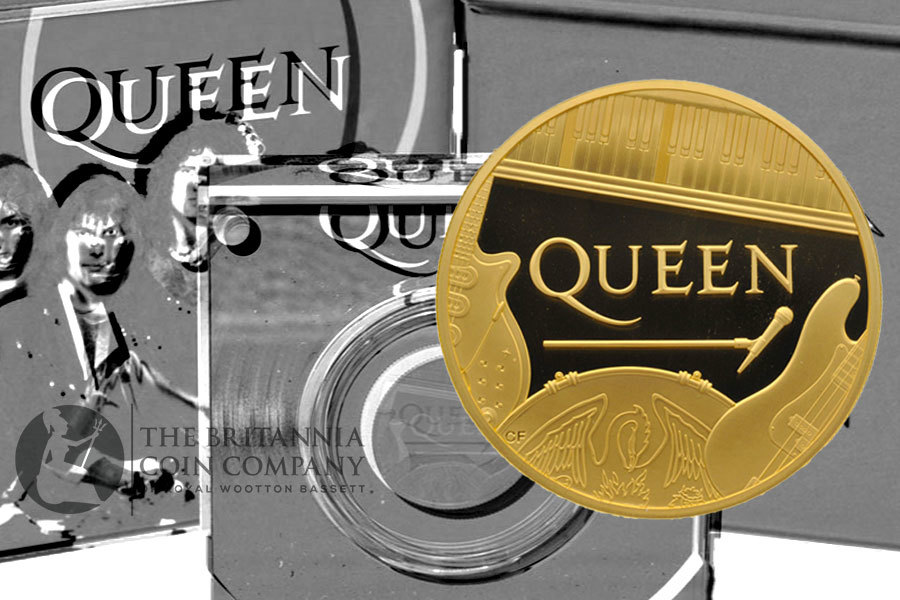
.jpg)
